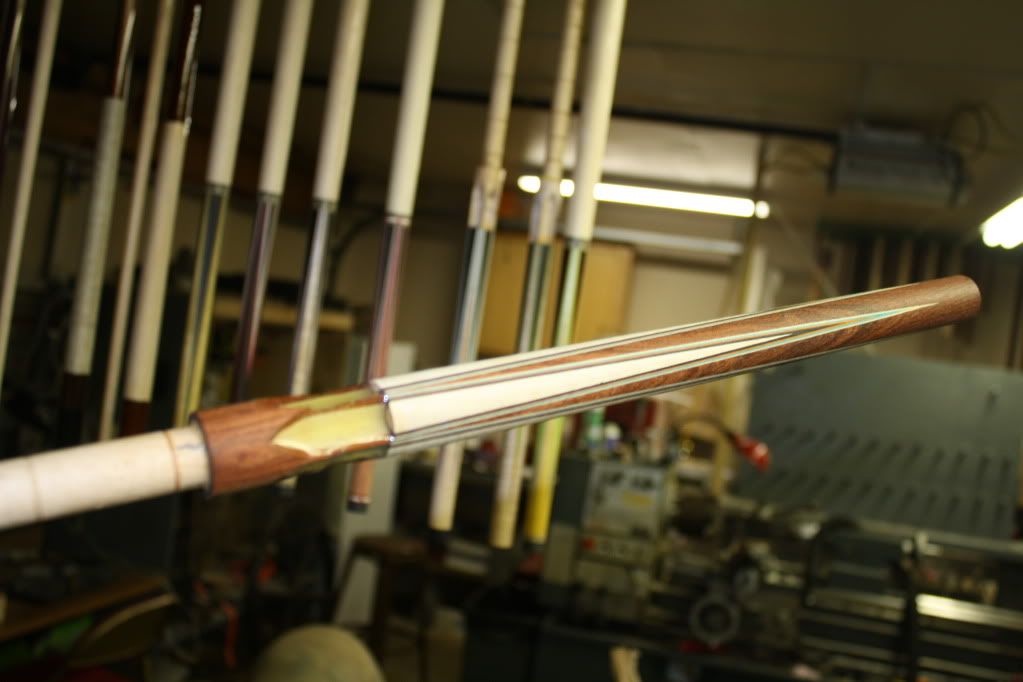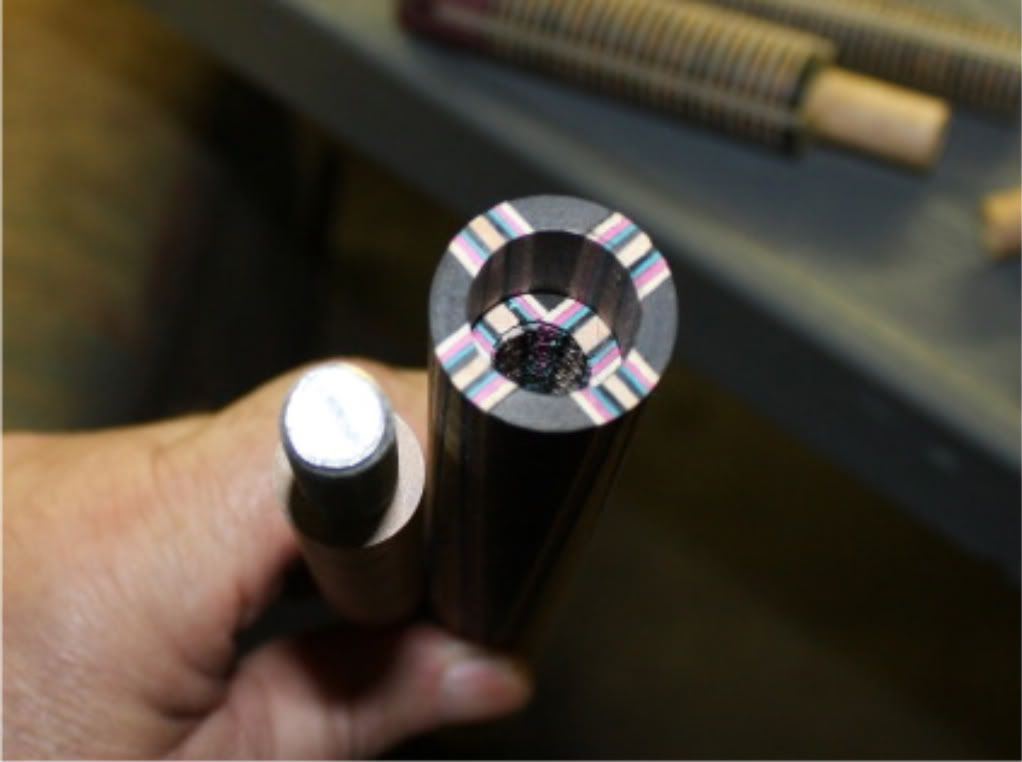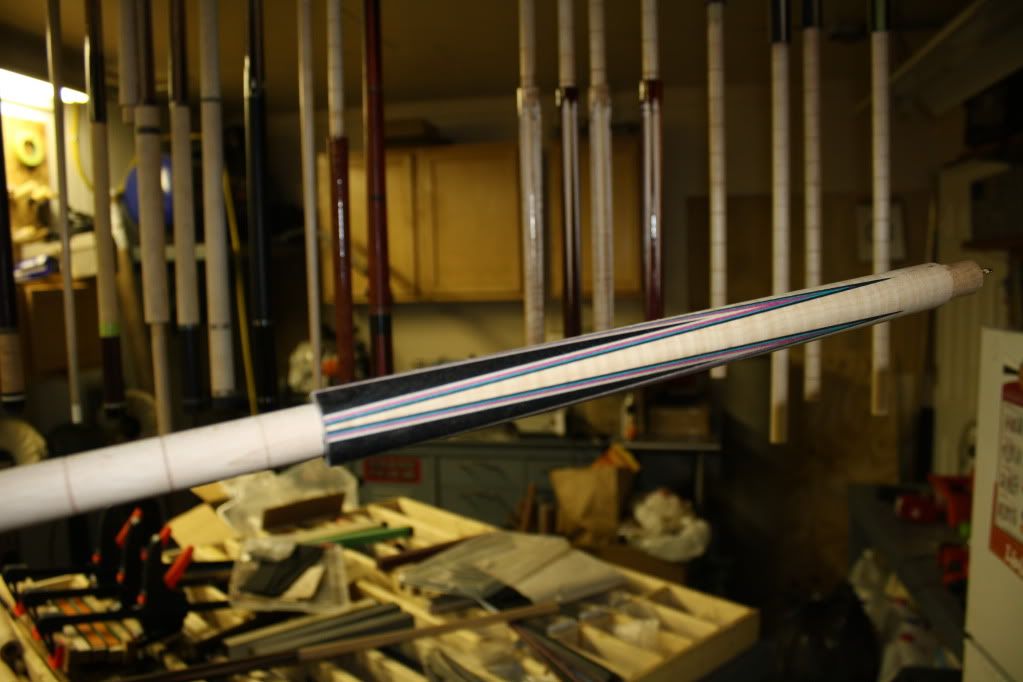Hi Joey,
Just curious, what does "resonate better" mean? By your suggestion one might think that everyone who plays pool wants to have some type of selective resonance ideal. This I know is not the case and is especially true with ferrule selection for example.
If that's the case, why pick the best sounding shafts then?
You can send me all your pingiest shafts and I'll send you my dudly sounding ones but they will be straight.
Balance is a function of physics not "better balance" and compared to what? Balance in a cue is a function of a CG. This is dictated by a fulcrum, moment arms and cumulative distances fore and aft with in an envelope.
True. But, I'd still want less weight behind the pin and put some in the middle of the butt if needed. And least at the bottom too.
The guitar comparison does not qualify for any type of null hypothesis as there are a lot of players that seek and prefer a soft or quiet sound that maple is so famous for. It would only make sense that a 3/4" dowel running through a cue would be good for that type of player but is totally subjective in selection. Quiet or high pitch resonance, there is not better, just different.
Compare a full maple butt to a chopped house cue with purpleheart bottom.
Make them at 15 oz. Which do you think will get more votes from them as the better hitting one ?
I concede that there are many people who wish to hear a ring tone when they hit a cue and that's is a great ideal to strive for in your cue engineering. Since the shock wave that occurs when striking a ball is through the cue is milliseconds any feedback that a player's nerve sensitivity can detect is doubtless auditory only but I could be wrong on that one and will stand corrected if proved otherwise.
They don't need to hear it. They need to feel it. You can surely lower the deflection of your shaft by drilling a hole on top but that will kill the hit and tone. Since the shock wave is only milliseconds, it shouldn't matter, right ?
I strive to maximize the feedback to the griphand. Muscle memory is funny but I want the player to feel how he hit the cueball.
IMHO, no way is better, just a different flavor.
True, mine was an opinion too.
Notice how I did not bring up the fact that coring is better because cored cues are less likely to warp. That's just my take on it , I am not saying better.
I didn't say none cored cues are better.
Hey Joey,
After reading your posts over the years I understand that you pay a lot of attention to detail concerning ring tone in your cues and the wood combos you use to make your cues which is noteworthy and Joey cues are known as great playing cues to say the least. I also understand that your have a very special joinery method for your A joint connection the you have perfected which requires a lot of extra time a effort to produce. These are just some of the things that makes a Joey cue selectively what it is and I am sure you have a lot of other great fine tuning things in your repertoire.
To say you and I or other full core guys are at two different ends of the spectrum would be an understatement. When we both put our point of views out there in the forum you and I have disagreed from time to time to put it bluntly but through those interactions I known I have grown a little by hearing your feed back and I hope that I have done the same in a small way to reciprocate in your direction.
With that being said, I wish to get back to the subject at hand and give my response to some of the new observations you have just made. Not to knock them at all but to act as a counterpoint an offer my point of view and take on the subject.
"You can send me all your pingiest shafts and I'll send you my dudly sounding ones but they will be straight".
My friend and neighbor John Wright gave me DPK's book about cue making and I studied it over and over. John had sold me my first cue made by David in the mid 80s and even a hack pool player like me could understand how good his cues played.
Part of what I learned about cue making from that book is that shaft wood should be culled and selected by buying planks and collating them for a variety of features. I feel that density is the biggest singular feature element in that selection. Type of grain cut, no run out, clearness, and straightness without crowning or bending can all be present in the 5/4 kiln dried planks I inspect but if it is a light board and not to my specs. concerning weight I reject it.
I can go through 100 planks and get 2 or 3 pedigree planks or I can go through 200 planks and get 1 or two only. Last month Darrin went through a bunk of 200 and only got one. That is the randomness of this process. Then seasoning them in a tapered form for years before they are matched up for a pair. I remember Eric posting about how he talked to a wood milling expert and he told Eric that quantity supplying the type of high quality maple that he specs. for his cues would not be possible as it is so hard to come by. That's why I go to my source after they get new shipments in and browse the bunks. It is the only way as far as I am concerned.
After doing all of this I will make no bones about it, I could care less about how one sounds compared to another and truly believe that my process control will give my end user the absolute best opportunity to get a great playing shaft that I know will be at least 3.9 oz. or I will reject it. From the time I dowel each shaft I know and have a chart that tells me what a 10.8 oz dowel 30" x 1" dia.
(for example) will weight at my final taper but sometimes that can be off just a little because as you know we are working with wood. My rejection rate is about 6 or 7 % doing it this way. When you think about it when a shaft producer gets random planks and produces dowels what are your chances of getting select pedigree material. I can see why culling by ring tone could be useful for finding playable shafts.
So my answer to your offer is
no, I would never trade shafts with anyone. And if your process is to cull your heard by using a tuning fork or your selective ear, I say go for it and I know in the final analysis you going to put out a kick ass cue because I know you care very deeply about it. If you are buying your shaft wood precut from a shaft merchant I would suggest to you as a friend to try my method I copied from the master himself, DPK. IMO buying shaft wood any other way is like getting a dog from a puppy farm. Sure there will always be some good ones in there but for the most part it is a pig in a poke.
True. But, I'd still want less weight behind the pin and put some in the middle of the butt if needed. And least at the bottom too.
Since this thread is about coring and you bring up the subject of weight, I would like to sound off in this area. When I first started building cues and was faced with making a cue out of different material and want to land the butt at lets say 14.5 oz., I would compensate with my A joint bolt at 1/2 by 13 tpi in steel because I found that most of the cues were always a little light unless I was using ebony or other select heavy woods.
I made wood specific gravity charts and calculated the volume of my final taper to try to have control over this process. When someone ordered a custom cue from me and wanted a certain weight I was as nervous as a whore in church because my cues are forward balanced by design and throwing a weight bolt in the back to load up a cue to make weight makes me sick.
After going to full coring all of my cues, I never give weight and balance a single thought until the cue is at final dimension and I am ready to install the pin. Then I just put the cue, shaft, joint pin, rubber bumper and some weight on the scale to the weight I want after adding the wrap and finish values. Now it is an easy job thing to install a 1/2" x 13 tpi weight bolt
(I have 1/4, 1/2, 3/4, 1 and 2 oz. in stock for this purpose) threaded and epoxied behind the pin and glue up an insert in front of it to be taped for the joint pin. The rear weight is not to load up the cue to make weight is just for compensating the balance point to the area I want.
I don't know why you are so against a small weight up front. It's not like it is a LD Shaft or something. When you are fully coring you have to add weight because you don't have an A joint weight. Putting it in the back only does not get the job done but the cue becomes back heavy.
BTW, I will share some info I have gained from my good friend Stew Mortson who is 88 years old and has been around the block in our biz for many decades. He lived in North Hollywood and set up Red Baker's lathes in the 60s, worked as a master panto artist for Bert Schrager when he busted into the Japanese market and just finished his career here in Palatine after ten years when Ray Ray Schuler passed. Stew knew Harvey Martin and told me that not only was Harvey the first guy or one of the first guys to go to the flat face joint and big pin exclusively but he routinely placed a weight behind his joint pin to balance his cues. Only an insider would have known this and it is from Stew's mouth to our ears. Back in the day these old timers were very protective about there shop procedures.
I just found this out recently as Stew hangs out 3 days a week at my shop as he can't play golf now and revealed this after talking about the subject in depth.
IMHO, if you are going to core a cue from stem to stern, you must face the issue of weight and I believe it is mandatory to use a forward weight to control the balance and CG with the back weight as a compensating bolt if needed. When ever I can, I don't use the back bolt at all but still drill and tap out the pocket so the player has the option to go heavier and since I produce cues that are forward weighted about 1 to 1.5 inches more than the average CM, that player will not back load the CG if he does add a bolt at some point in the future.
Just my take on it.
Rick
PS:
Anyone who wants a copy of David's book on Cue Making, PM me your email address and I will send you a PDF copy.
A Joint with 1/2 13 tpi x 3" to make the weight when I was doing many A Joint Cues before coring everything. This was my last A joint cue made.
Even when I was doing A Joints I still cored from the A position back before I started cutting point grooves on the core.


